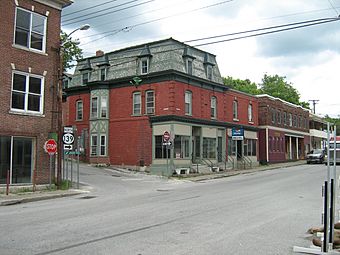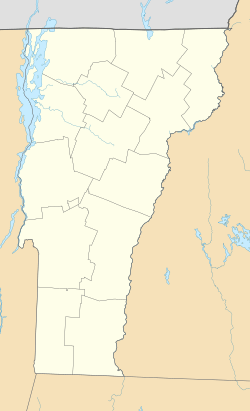Downtown Richford Historic District facts for kids
Quick facts for kids |
|
|
Downtown Richford Historic District
|
|
 |
|
| Location | Main and River Sts., Richford, Vermont |
|---|---|
| Area | 12 acres (4.9 ha) |
| Architectural style | Italianate, Queen Anne |
| NRHP reference No. | 80000333 |
| Added to NRHP | August 22, 1980 |
The Downtown Richford Historic District is a special area in the heart of Richford, Vermont. It includes many old shops and factories. Most of these buildings are made of brick. They were built between 1880 and 1920.
You can find them mostly around where Main Street and River Street meet. Some old factories are just across the Missisquoi River. The river's water was very important. It provided power for the businesses that helped the town grow. This historic district was added to the National Register of Historic Places in 1980. This means it's a place worth protecting because of its history.
Exploring Richford's History
The town of Richford in northern Vermont started in the late 1700s. Early settlers built sawmills and gristmills there. These mills used the power from the Missisquoi River's waterfalls.
In the 1850s, Richford became an important place for trade and industry. This happened because it became easier to trade with nearby Quebec. More people from French-speaking areas moved to Richford. This brought new markets for local goods.
The mills were mostly on the south side of the waterfalls. Water was moved into a special channel to power them. The town's main shopping area grew on the north side of the falls. After World War I, the town became less busy. It has stayed quieter ever since.
Buildings of the District
The historic district has both shops and factory buildings. They are on both sides of the Missisquoi River. Main Street crosses the river on a bridge built in 1928. This bridge was built after a big flood in 1927 washed away the old one.
From the corner of Main and River Streets, you'll see brick buildings. These old shops stretch east and west along River Street. They were mostly built between 1880 and 1920. They show popular styles from that time, like Italianate and Queen Anne.
South of the river, on the west side of Main Street, are two factory buildings. They were built in 1908 by the Sweat-Comings Company. These buildings are made from concrete blocks. The town's fire station is also nearby. It was also built with concrete blocks.



